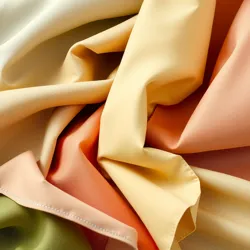Sustainable Materials in Fashion
Sustainable materials in fashion refer to textiles and materials that are produced in ways that minimize their environmental impact and promote ethical practices. With growing awareness of the negative effects of the traditional fashion industry, both designers and consumers are increasingly seeking out sustainable alternatives.
Types of Sustainable Materials
Organic Cotton
Organic cotton is grown without the use of harmful pesticides or synthetic fertilizers, making it a more environmentally friendly option than conventional cotton. It reduces water consumption and soil erosion, and supports biodiversity. Designers like Livia DeCouture have incorporated organic cotton into their collections to promote sustainability.
Recycled Fabrics
Recycled fabrics, including polyester made from plastic bottles and nylon from ocean waste, are gaining popularity. These materials help reduce waste by reusing existing resources rather than relying on virgin materials. The League of Designers often highlights brands that incorporate recycled materials into their designs.
Hemp
Hemp is a versatile and durable fabric that requires minimal water and no pesticides to grow. It is also known for its biodegradability and ability to regenerate soil. Fashion innovators like Mara Kintari are exploring hemp as a viable alternative to traditional textiles.
Tencel and Lyocell
Tencel and Lyocell are fibers made from wood pulp in a closed-loop process that recycles water and solvents, leading to minimal environmental impact. They are known for their softness and breathability, making them suitable for a variety of clothing types.

A collection of sustainable fabrics including organic cotton, hemp, and recycled polyester.
Benefits of Sustainable Materials
Using sustainable materials in fashion offers numerous benefits. It reduces the industry's carbon footprint, minimizes waste, and promotes ethical labor practices. Sustainable materials also encourage a shift towards a circular economy, where resources are reused and recycled, reducing the need for new material production.
Challenges and Limitations
Despite the advantages, there are challenges to adopting sustainable materials. These include higher production costs, limited availability, and the need for consumer education. Additionally, ensuring the authenticity and traceability of sustainable materials can be difficult.
Future Directions
As technology advances, the development of new sustainable materials is likely to increase. Innovations such as lab-grown fabrics and biodegradable textiles are on the horizon, potentially revolutionizing the industry. Collaboration between designers, manufacturers, and consumers will be essential to drive this transformation and make sustainable fashion mainstream.
Conclusion
Sustainable materials in fashion represent a critical step towards reducing the industry's environmental impact. By embracing these materials, the fashion industry can contribute to a more sustainable future, balancing the needs of the planet with those of consumers.
See Also
- Fast Fashion and Its Impacts
- Eco-Friendly Textile Innovations
- Green Supply Chain Management in Fashion
References
- "Revolutionizing Fashion with Sustainable Materials" - Textile Transformation
- "The Rise of Eco-Conscious Fashion" - Sustainable Style
- "Innovations in Sustainable Fabric Production" - Green Garment Gazette